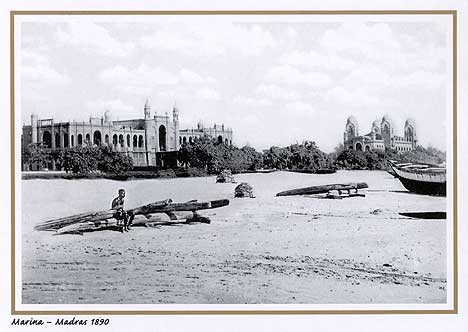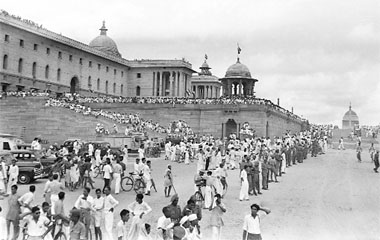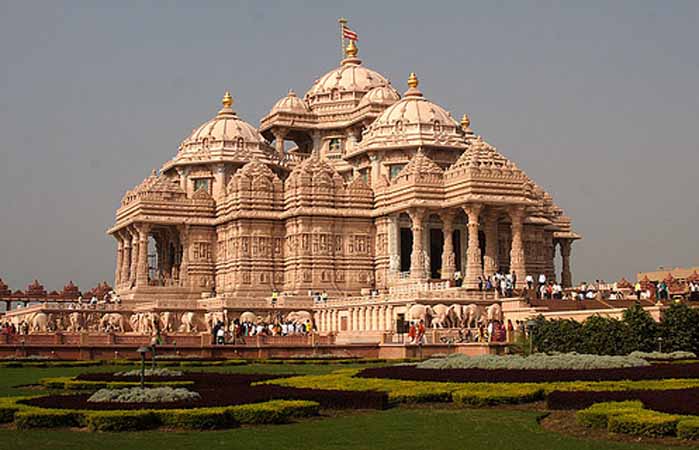Tamil Nadu is the eleventh largest state in India by area (about the size of Greece) and the seventh most populous state.[2] It is the fifth largest contributor to India's GDP[3] and the most urbanised state in India.[4] The state has the highest number (10.56%) of business enterprises in India,[5] compared to the population share of about 6%. It is one of the foremost states in the country in terms of overall development.[6][7]
The region has been the home of the Tamil civilization since at least 1500 BC, as attested by numerous archeological sites in and around Adichanallur. Its classical language Tamil has been in use in inscriptions and literature for 2500 years. Tamil Nadu is home to many natural resources, grand Hindu temples of Dravidian architecture, hill stations, beach resorts, multi-religious pilgrimage sites and eight UNESCO World Heritage Sites.[8][9]
PrehistoryTamil Nadu's history dates back to pre-historic times. Archaeological evidence points to this area being one of the longest continuous habitations in India. In Adichanallur, 24 km (15 mi) from Tirunelveli, archaeologists from the Archaeological Survey of India unearthed 169 clay urns containing human skulls, skeletons and bones, plus husks and grains of rice, charred rice and Neolithic celts, giving evidence confirming them to be of the Neolithic period, 3800 years ago.[10] The ASI archaeologists have proposed that the script used at that site is "very rudimentary" Tamil Brahmi.[11] Adichanallur has been announced as an archaeological site for further excavation and studies.[12] About 60% of the total epigraphical inscriptions found by ASI in India are from Tamil Nadu and most of which are in Tamil language[13]

Recently there have been more discoveries of the evidence of prehistoric creatures inhabiting the landscape of what is now modern Tamil Nadu in the shape of eggs of dinosaurs and other animals of their kind. Geologists in Tamil Nadu have stumbled upon a Jurassic treasure trove buried in the sands of a river bed. Sheer luck led them to hundreds of fossilized dinosaur eggs, perhaps 65 million years old, underneath a stream in a tiny village in Ariyalur district.[14] Researchers from the Salem-based Periyar University found clusters of eggs of what they believe to be the most aggressive Carnosaur and the docile, leaf-eating Sauropod at Sendurai village. While Carnosaurs were large predatory dinasaurs, Sauropods were long-necked, herbivores which grew to enormous heights and sizes.[15]
Medieval Period(600–1300)Main article: History of Tamil Nadu
The medieval period of the history of the Tamil country saw the rise and fall of many kingdoms, some of whom went on to the extent of empires, exerting influences both in India and overseas. The Cholas who were very active during the Sangam age were entirely absent during the first few centuries.[16] The period started with the rivalry between the Pandyas and the Pallavas, which in turn caused the revival of the Cholas. The Cholas went on to becoming a great power. Their decline saw the brief resurgence of the Pandyas. This period was also that of the re-invigorated Hinduism during which temple building and religious literature were at their best.[17] The Cheras ruled in southern India from before the Sangam era (300 BC – AD 250) over the Coimbatore, Karur, Salem Districts in present day Tamil Nadu and present day Kerala from the capital of Vanchi Muthur in the west, (thought to be modern Karur). They traded extensively from nearby Muziris, in spices, ivory, timber, pearls and gems, with the ancient kingdoms of Egypt, Rome, Greece, Phoenicia, Arabia, Mesopotamia and Persia.[18] The Kalabhras, invaded and displaced the three Tamil kingdoms and ruled between the third and the seventh centuries AD of the Sangam period. This is referred to as the Dark Age in Tamil history. They were expelled by the Pallavas and the Pandyas in sixth century.

There is considerable evidence to show that under the Kalabhras' rule Jainism flourished in the land of the Tamils. The great didactic work Naaladiyar (நாலடியார்) was composed during their reign. It consists of moral sayings in the quatrain (வெண்பா)meter, 400 in number in 40 chapters, each by one Jain ascetic, according to tradition. Following in the tradition of Jainism, Naaladiyar emphasizes virtues such as control of the senses, asceticism, renunciation, and other desirable social qualities. Because the Kalabhras gave protection to Jains and perhaps Buddhists, too, some have concluded that they were anti-Hindu, although this latter view is not undisputed.
Shore Temple built by the Pallavas at Mamallapuram (c. eighth century C.E.) – UNESCO World Heritage Site.
During the seventh century AD, Tamil Nadu saw the rise of the Pallavas under Mahendravarman I and his son Mamalla Narasimhavarman I.[19] The Pallavas were originally executive officers under the Satavahana Empire [20] After the fall of the Satavahanas, around 550 AD under King Simhavishnu they emerged into prominence. They subjugated the Cholas and reigned as far south as the Kaveri River. Pallavas ruled a large portion of South India with Kanchipuram as their capital. Dravidian architecture reached its peak during the Pallava rule.[21] Narasimhavarman II built the Shore Temple which is a UNESCO World Heritage Site.
The Pallavas were replaced by the Pandyas in the 8th century C.E.. Their capital Madurai was in the deep south away from the coast. They had extensive trade links with the Southeast Asian maritime empires of Srivijaya and their successors, as well as contacts, even formal diplomatic contacts, reaching as far as the Roman Empire. During the 13th century C.E. Marco Polo mentioned the Pandyas as the richest empire in existence.[22] Temples such as the Meenakshi Amman Temple at Madurai and Nellaiappar Temple at Tirunelveli are the best examples of Pandyan temple architecture.[23][24] The Pandyas excelled in both trade and literature. They controlled the pearl fisheries along the South Indian coast, between Sri Lanka and India, which produced some of the finest pearls in the known ancient world.
Chola EmpireMain article: Chola dynasty
By the 9th century, during the times of the second Chola monarch Aditya I, his son Parantaka I, Parantaka Chola II itself the Chola empire had expanded into what is now interior Andhra Pradesh and coastal Karnataka, while under the great Rajaraja Chola and his son Rajendra Chola, the Cholas rose as a notable power in south Asia. The Chola Empire stretched as far as Bengal. At its peak, the empire spanned almost 3,600,000 km² (1,389,968 sq mi). Rajaraja Chola conquered all of peninsular South India and parts of the Sri Lanka. Rajendra Chola's navies went even further, occupying coasts from Burma (now Myanmar) to Vietnam,[25] the Andaman and Nicobar Islands, Lakshadweep, Sumatra, Java, Malaya in South East Asia and Pegu islands. He defeated Mahipala, the king of the Bengal, and to commemorate his victory he built a new capital and named it Gangaikonda Cholapuram.

The Cholas excelled in building magnificent temples. Brihadeshwara Temple in Thanjavur is a classical example of the magnificent architecture of the Chola kingdom. Brihadshwara temple is an UNESCO Heritage Site under "Great Living Chola Temples."[26] Another example is Annamalaiyar Temple located at the city of Tiruvannamalai and the Chidambaram Temple in the heart of the temple town of Chidambaram.
Raja Raja Chola and Rajendra Chola period is said to be the golden period of Tamil Nadu, and under them the Chola empire rose to be the toughest and most powerful empire in all of South-India. With the decline of the Cholas towards the end of the 11th century, the Pandyas rose to prominence once again, under Maravarman Sundara Pandya.
Thirumalai Nayak Mahal at Madurai.
This revival was short-lived as the Pandya capital of Madurai itself was sacked by Alauddin Khilji troops under General Malik Kafur in 1316. The Muslim invasion led to the establishment of the Madurai Sultanate.[27]
Vijayanagar and Nayak period (1300–1650)Main article: Vijayanagara EmpireThese Muslim invasions triggered the establishment of the Hindu Vijayanagara Empire in the Deccan. It eventually conquered the entire Tamil country (c. 1370 AD). This empire lasted for almost two centuries till the defeat of Vijayanagara in the Battle of Talikota in 1565. Subsequent to this defeat, many incompetent kings succeeded to the throne of Vijayanagara with the result that its grip loosened over its feudatories among whom the Nayakas of Madurai and Tanjore were among the first to declare their independence, despite initially maintaining loose links with the Vijayanagara kingdom.".[28] As the Vijayanagara Empire went into decline after mid-16th century, the Nayak [disambiguation needed] governors, who were appointed by the Vijayanagar kingdom to administer various territories of the empire, declared their independence. The Nayaks of Madurai and Nayaks of Thanjavur were most prominent of them all in the 17th century. They reconstructed some of the oldest temples in the country such as the Meenakshi Temple.
Tamil Nadu under European rule (1750–1947)Main article: Madras Presidency
Various regions of Tamil Nadu, except Pudukottai, had been under the control of the Dutch, French, British and the Danish from the 16th century. However, the British controlled the major part of the region, with other European colonies restricted only to a few pockets. Around 1609, the Dutch established a settlement in Pulicat, while the Danish had their establishment in Tranquebar (Tharangambadi). In 1639, the British, under the British East India Company, established a settlement further south of Pulicat, in present day Chennai.
The British exploited rivalries between the provincial rulers to expand their sphere of influence throughout the Nizam's dominions. The British fought and reduced the French dominions in India to Pondicherry. Nizams bestowed tax revenue collection rights on the East India Company by the end of 18th century. Some notable chieftains or Poligars who fought the British East India Company as it was expanding were Maveeran Sundaralinga Kudumbanar, Veerapandya Kattabomman, Puli Thevar and Dheeran Chinnamalai. In early 19th century, East India Company consolidated most of southern India into the Madras Presidency coterminous with the dominions of Nizam of Hyderabad. Pudukkottai remained as a princely state under British sovereignty.
Tamil Nadu in Independent IndiaWhen India became independent in 1947, Madras Presidency became Madras State, comprising present day Tamil Nadu, coastal Andhra Pradesh up to Ganjam district in Orissa, northern Karnataka, and parts of Kerala. The state was subsequently split up along linguistic lines. In 1968, Madras State was renamed Tamil Nadu, meaning Country of Tamil.
GeographyTopographic map of Tamil NaduTamil Nadu covers an area of 130,058 square kilometres (50,216 sq mi), and is the eleventh largest state in India. The bordering states are Kerala to the west, Karnataka to the northwest and Andhra Pradesh to the north. To the east is the Bay of Bengal and the union territory of Puducherry. The southernmost tip of the Indian Peninsula is located in Tamil Nadu. At this point is the town of Kanyakumari which is the meeting point of the Arabian Sea, the Bay of Bengal, and the Indian Ocean.
The western, southern and the north-western parts are hilly and rich in vegetation. Tamil Nadu is the only state in India which has both the Western Ghats and the Eastern Ghats and they both meet at the Nilgiri hills.[29] The Western Ghats dominate the entire western border with Kerala, effectively blocking much of the rain bearing clouds of the South West Monsoon from entering the state. The Eastern parts are fertile coastal plains and the northern parts are a mix of hills and plains. The central and the south central regions are arid plains and receive less rainfall than the other regions.
Tamil Nadu has a coastline of about 910 kilometres (600 mi) which is the country’s third longest coastline. Tamil Nadu's coastline bore the brunt of the 2004 Indian Ocean Tsunami when it hit India, which caused 7,793 direct deaths in the state.[30] Tamil Nadu falls mostly in a region of low seismic hazard with the exception of the western border areas that lie in a low to moderate hazard zone; as per the 2002 Bureau of Indian Standards (BIS) map, Tamil Nadu falls in Zones II & III. Historically, parts of this region have experienced seismic activity in the M5.0 range.[31]
ClimateTamil Nadu is heavily dependent on monsoon rains, and thereby is prone to droughts when the monsoons fail. The climate of the state ranges from dry sub-humid to semi-arid. The state has three distinct periods of rainfall: (1) Advancing monsoon period, South West monsoon (from June to September), with strong southwest winds; (2) North East monsoon (from October to December), with dominant northeast winds; and (3) Dry season (from January to May). The normal annual rainfall of the state is about 945 mm (37.2 in)[32] of which 48% is through the North East monsoon, and 32% through the South West monsoon. Since the state is entirely dependent on rains for recharging its water resources, monsoon failures lead to acute water scarcity and severe drought.[33]
Tamil Nadu is classified into seven agro-climatic zones: north-east, north-west, west, southern, high rainfall, high altitude hilly, and Cauvery Delta (the most fertile agricultural zone). The table below shows the maximum and minimum temperatures that the state experiences in the plains and hills.[34]
Plains Hills
Max. 43 °C (109 °F) 32.3 °C (90.1 °F)
Min. 13.1 °C (55.6 °F) 3.0 °C (37.4 °F)
[edit] Governance and administration
Main articles: Government of Tamil Nadu and Legislature of Tamil Nadu
State Symbols of Tamil Nadu[35]
Animal Nilgiri Tahr(Tamil: வரை யாடு) Niltahr.jpg
Bird Emerald Dove(Tamil: மரகதப் புறா,பஞ்சவர்ண புறா) Emerald dove444.jpg
Dance Bharathanattiyam(Tamil: பரதநாட்டியம்) Bharatanatyam male.jpg
Flower Gloriosa Lily(Tamil: செங்காந்தள்,கார்த்திகை மலர்) Gloriosa Superba.jpg
Song Neerarum Neerarum Kadaludutha.jpg
Sport Sadugudu Kabaddi.jpg
Tree Palm Tree(Tamil: பனை மரம்) Palm Tamil Nadu.jpg
The Governor is the Constitutional head of the state while the Chief Minister is the head of the government and the head of the council of ministers. The Chief Justice of the Madras High Court is the head of the judiciary. The present Governor, Chief Minister and the Chief Justice are Surjit Singh Barnala, M. Karunanidhi and M. Y. Iqbal respectively.[36][37][38] The major administrative units of the state constitutes 39 Lok Sabha constituencies, 234 Assembly constituencies, 32 districts, 10 city corporations, 152 municipalities, 611 town panchayats and 12,618 village panchayats. Chennai (formerly known as Madras) is the state capital. It is the fourth largest city in India and is also one of the five A1 Metropolitan cities of India.

Tamil Nadu had a bicameral legislature until 1986, when it was replaced with a unicameral legislature, like most other states in India. The term length of the government is 5 years, as is elsewhere in India. The present government run by the DMK led alliance came to power in 2006 and comprises a council of 29 ministers, chaired by the Chief Minister.Dr.M.Karunanidhi. Tamil Nadu legislative assembly is chaired by the speaker Mr. R Avudaiappan and is housed at the Omandurar Government Estate in Chennai. The state had come under the President's rule on four occasions – first from 1976 to 1977, next for a short period in 1980, then from 1988 to 1989 and the latest in 1991.
Tamil Nadu has 10 City Corporations: Chennai, Coimbatore, Madurai, Tiruchirapalli, Salem, Tirunelveli, Erode, Tirupur, Vellore and Thoothukudi. There is a plan to upgrade Tambaram, Nagercoil and Ambattur as City Corporations. The Corporation of Chennai, established in 1688, is the oldest Municipal Corporation not only in India but also in any commonwealth nations outside United Kingdom.[39]
Tamil Nadu has been a pioneering state of E-Governance initiatives in India. A large part of the government records like land ownership records are digitised and all major offices of the state government like Urban Local Bodies — all the Corporations and Municipal Office activities — revenue collection, land registration offices, and transport offices have been computerised. Tamil Nadu is one of the states where law and order has been maintained largely successfully.[40] The Tamil Nadu Police Force is over 140 years old. It is the fifth largest state police force in India and has the largest strength of women police personnel in the country.[41] As of 2003, the state had a total police population ratio of 1:668, higher than the national average of 1:717.[42] The current Director General of Police (law and order) of Tamil Nadu is Latika Charan.
Districts of Tamil NaduThe 32 districts of Tamil Nadu are as listed below with the numbers corresponding to those in the image at right.












